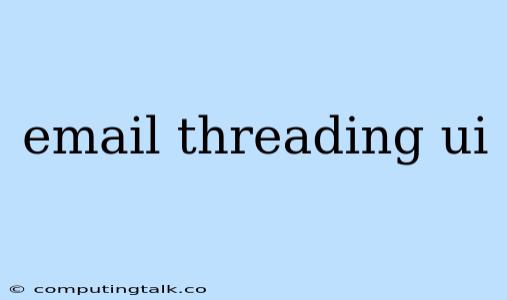Email threading is a fundamental feature in email clients, enabling users to understand the flow of conversations easily. It allows for the grouping of related messages, making it simpler to follow the context of an email exchange. This article will delve into the design considerations and best practices for creating an effective email threading UI.
Understanding Email Threading UI
Email threading UI essentially presents a structured view of emails, arranging them in a way that visually represents the conversation's flow. It can be achieved through different approaches:
1. Linear Threads:
- This is the most common approach. Emails are listed chronologically, and replies are indented beneath the original message, creating a clear hierarchy.
- This method makes it easy to identify the initial email and track the progression of replies.
2. Conversation View:
- In this approach, emails are grouped by conversation subject. Replies are displayed in a linear fashion, but all messages related to a specific topic are grouped together.
- This view emphasizes the conversational aspect and is especially useful for managing large volumes of emails.
Key Considerations for Designing an Effective Email Threading UI
1. Visual Clarity:
- The UI should be designed for easy readability and intuitive understanding.
- Use clear visual cues, such as indentation, colors, and icons, to differentiate between original messages and replies.
- Example: A common practice is to use different background colors for alternating messages, making it easier to scan the conversation.
2. Navigation and Filtering:
- Filter Options: Allow users to filter emails by sender, date, subject, or keywords. This can help quickly locate specific messages within a long thread.
- Jump to Specific Messages: Provide a way to jump directly to specific messages within the thread, such as a message list or using clickable timestamps.
3. User Actions and Context:
- Replying: Make it easy for users to reply to specific messages within the thread. The reply interface should be contextual, indicating which message the user is replying to.
- Forwarding: Ensure users can easily forward selected messages or the entire thread.
- Marking and Actions: Provide options for marking emails as read/unread, flagging important messages, or archiving threads.
4. Performance and Efficiency:
- Loading Speed: Ensure fast loading times, even for long email threads. Consider using pagination or lazy loading techniques for large conversations.
- Data Management: Efficiently handle large volumes of emails and ensure smooth scrolling through long threads.
5. Accessibility:
- Keyboard Navigation: Allow users to navigate the thread using the keyboard, especially for users who rely on assistive technologies.
- Screen Reader Compatibility: Make sure the UI is accessible to screen readers, providing alternative text for visual elements like icons and colors.
Best Practices for Email Threading UI Design
- Concise and Clear: Keep the UI simple and free from unnecessary clutter.
- User-Centered Design: Design with the user in mind. Consider the typical email usage patterns and make the UI intuitive and efficient.
- Consistent Design: Maintain consistent design elements throughout the email client, ensuring a cohesive user experience.
- Testing: Conduct user testing to evaluate the usability and effectiveness of the UI design.
Conclusion
A well-designed email threading UI is essential for a smooth and efficient email experience. By prioritizing clarity, user-friendliness, and accessibility, developers can create an interface that helps users navigate and manage their email conversations effectively.
